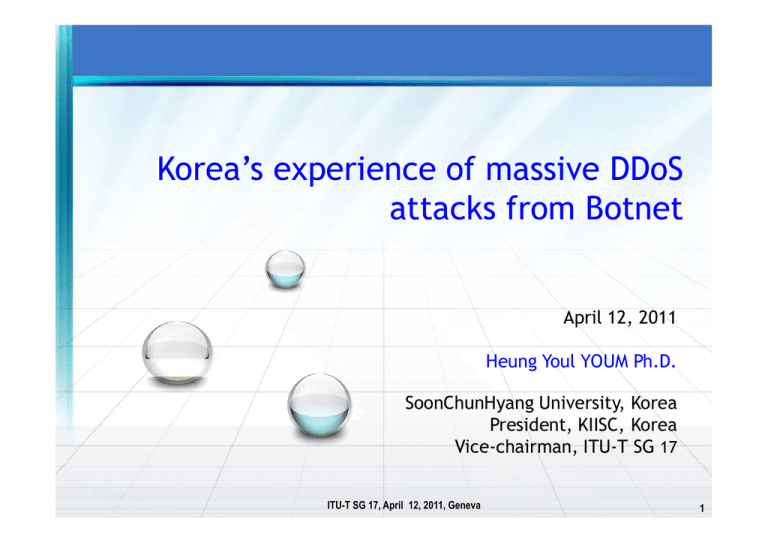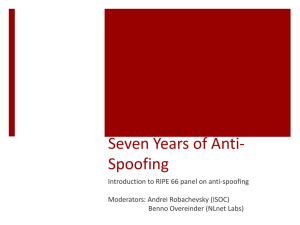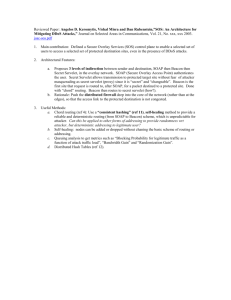Korea’s experience of massive DDoS attacks from Botnet April 12, 2011
advertisement

Korea’s experience of massive DDoS attacks from Botnet April 12, 2011 Heung Youl YOUM Ph.D. SoonChunHyang University, Korea President, KIISC, Korea Vice-chairman, ITU-T SG 17 ITU-T SG 17, April 12, 2011, Geneva 1 Table of Contents Overview of 7.7 /3.4 Botnet attack 7.7 DDoS Attack –scenario 7.7 DDoS Attack – characteristics 3.4 DDoS Attack –scenario 3.4 DDoS Attack – characteristics DDoS attack – how to respond to DDoS attack Countermeasures– legal & technical countermeasures Technical countermeasure - DNS sinkhole scheme Countermeasures– legal countermeasures Countermeasures– online checking / help-desk service Concluding remark ITU-T SG 17, April 12, 2011, Geneva 2 DDoS Attacks – scenario Typical DDoS attack scenario 7. Forwards an attack command C&C Servers 8. Launch DDoS attack to Target web site. 1. Compromise C&C Servers 6. Issue an attack command. Target website Hacker 2. Compromise a legitimate server. · · · Web sites used for distributing malware 3. Inject malwares into the web site of exploited server. • Disallow other users to visit this web site at the time of the attack. Bot 4. When user visits the website, the malware is downloaded to user’s computer. Bot-infected computers 5. Malware is installed on user’s computer. ITU-T SG 17, April 12, 2011, Geneva 3 Overview of 7.7 Botnet attacks 7.7 DDoS attack Labeled 7.7 cyber terror by the media, § due to the first date when this attack occurred in Korea, July 7th, 2009 and carrying out three separate dates. § First massive DDoS attack, resulted in shutting down of victim sites for a while. 7.7 DDoS attack-characteristics No attack commands from C&C servers – most attack activities are initiated by each Bot-infected computer, instead of C&C server. 538 compromised servers mostly outside Korea were used. Sophisticated structure of malware used for DDoS attack Lots of zombie computers were used. - 115,044 zombie computers. Well organized and scheduled attacks scenario operated like a time bomb. Still, we don’t know the purpose&source of this attack. ITU-T SG 17, April 12, 2011, Geneva 4 7.7 DDoS Attacks – scenario 7.7/3.4 DDoS attack scenario Bot-infected computers 3. When downloading the patch, the malware is also downloaded into user’s computer. 5. Launch DDoS attack based on the scheduler programmed in the malware. DDoS Traffic 4. The malware is also Installed, turning user’s computer into Zombie computer. 1. Hack the server for providing Internet web hard service based p2p techniques. · · · Hacker(s) r(s) 2. Embed malwares Bot into the patch for providing service Web sites used for for providing web distributing malwares hard. Target website(s) Exploited servers § ITU-T SG 17, April 12, 2011, Geneva To update malware and a list of attack targets. 5 7.7 DDoS Attack – characteristics Timelines of DDoS attacks 2nd Attack(DDoS) 1st Attack(DDoS) Zombie computers: 26,209 7th July 18:00 PM ~ 8th July 8:00 AM, 2009 Victims: 26 sites(US & Korea) 3rd Attack(DDoS) Zombie computers: 47,123 8th July 18:00 PM ~ 9th July 6:00 AM, 2009 Victims: 16 sites(Korea) 4th attack(Virus) Zombie computers: 41,712 9th July 18:00 PM ~ 10th July 6:00 AM, 2009 Victims: 7 sites(Korea) To destruct the hard disk in Zombie computers 10th July 10:00 AM ~ Total zombie computers: 115,044, Total Victim sites: 36 Number of dedicated vaccines installed by users: 2,580,000 ITU-T SG 17, April 12, 2011, Geneva 6 Overview of 3.4 Botnet attacks 3.4 DDoS attack Labeled 3.4 DDoS attack by the media, § due to the first date when this attack occurred in Korea, March 4th, 2011. § Due to the well organized public-private partnership and improved technical response established since the 7.7 DDoS attack, no serious damages were made. 3.4 DDoS attack-characteristics Many exploited servers such as malware distribution server, command distribution server – most attack activities first initiated by each Bot-infected computer. 748 compromised servers being mostly outside Korea were used. Similar structured malwares & attack scenarios as the 7.7 attack & are used for DDoS attack. 7 compromised local websites used for distributing malware to users Zombie computers used to 7.7 DDoS attack– about 116,299 zombie computers. ITU-T SG 17, April 12, 2011, Geneva 7 3.4 DDoS Attack – characteristics Timelines of 3.4 DDoS attacks 2nd Attack(DDoS) 1st Attack(DDoS) Zombie computers: 24,696 4th March, 2011 10:00 AM ~ Victims: 29 sites 3rd Attack(DDoS) Zombie computers: 51,434 4th March, 2011 18:00 PM ~ Victims: 40 sites 4th Attack(DDoS) Zombie computers: 11,310 5th March, 2011 10:00 AM ~ Victims: 29 sites To destruct the hard disk in Zombie computers 5th March, 18:30 PM ~ Total zombie computers: 116,299, Total Victim sites: 40 Number of dedicated vaccines installed by users :11,510,000 ITU-T SG 17, April 12, 2011, Geneva 8 DDoS attack – how to respond to DDoS attack Servers used for storing private files from Zombie computers Servers used for distributing malware Target websites • Blocking communication to exploited servers § DDoS prevention solutions used. Servers used for updating malware/attack targets and managing zombie computers ISP Block connection to Compromised Servers Raise national alert level to attention Zombie computers Private sectors Information sharing Free-of-charge vaccine program Disinfect Zombies ITU-T SG 17, April 12, 2011, Geneva KISA/KCC/Portals/Anti-virus companies/ISPs 9 Countermeasures– three pillars Technical framework Improved a real-time framework for enabling early detection, early warning, and effective response to DDoS attacks. Improve the real-time response system including as well as deploying DDoS prevention solutions and Bot-disinfection system. Sharing of incident data Improve a real-time exchange framework of incident-related data and collaborations between KISA/KCC/NCSC and private sectors including major anti-vaccine companies and ISPs and among ISPs to respond to incidents collectively. Legal framework To improve roles&responsibility of ISP, ASP, and Internet users to protect against DDoS attack by enacting “Law on malware spreading prevention” called “Zombie PC prevention law”. ITU-T SG 17, April 12, 2011, Geneva 10 Technical countermeasures – DNS sinkhole scheme DNS sinkhole scheme Launched since 2005 by KrCERT/CC(Korea Internet Security Center, http://www.krcert.or.kr/index.jsp), part of KISA(Korea Internet&Security Agency, www.kisa.or.kr). To protect aganist Botnet attacks, that is, to block the communication between bot-infected computers and C&C servers, making them to remain dormant. With collaboration of ISP, the IP address of the domain name of the C&C servers are changed to that of DNS sinkhole server deployed by KISA. As of September, 2010, about 60 organizations including major ISPs are employing DNS sinkhole scheme. An average of 2,000 domain names are blocked by the scheme. Part of ITU-T X.1205 Supplement approved by ITU-T SG17 Question 4 . In case of Botnet using C&C server, it works against Botnet attacks. ITU-T SG 17, April 12, 2011, Geneva 11 DNS sinkhole scheme – effectiveness Without DNS sinkhole scheme With DNS sinkhole scheme Bot C&C Bot C&C ④ Issue attack command. ③ Connect with C&C server. KISA Sinkhole server Target Sites § Collect information on Bot infected computer’s. ③ Connect with KISA sinkhole server. ⑤ DDoS Attack ② Send back IP address of KISA sink hole. ② Return back IP address of C&C server. ① C&C DNS query Bot infected computers ① C&C DNS query ISP DNS server Bot infected computers ITU-T SG 17, April 12, 2011, Geneva ISP’s DNS server 12 Legal framework – a zombie PC prevention law (Draft) Objectives A legal framework to ensure that early warning and effective response and recovery are in place. Filed at December 2010 by Korean parliament and expected to start a public consultation process from April 2011. Contents Grant ISP’s right to block communication from infected computers in an emergency state. Enable access to zombie computers for collecting malware’s sample. Improve role and responsibility of ISP, ASP, users in terms of preventing zombie computer. Issues Concerns about privacy concerns raised – concerns about potentially using deep packet inspection technology. http://www.zdnet.com/blog/security/zombie-pc-prevention-bill-to-make-security-software-mandatory/8487 ITU-T SG 17, April 12, 2011, Geneva 13 Countermeasure - Online bot-infection checking service Online bot-infection checking service Provided by KrCERT/CC in KISA. § http://www.boho.or.kr/pccheck/pcch_03.jsp?page_id=3 To check if the computer in question is infected with bots. Use database collected & monitored from DNS sinkhole scheme. Your computers on IP address(x.x.x.x) is not infected by the malicious bots known to KrCERT/CC. ITU-T SG 17, April 12, 2011, Geneva 14 Countermeasure – Online help-desk service Online help-desk service Is called e – 118 service Provided by the KrCERT/CC, part of KISA. § http://www.boho.or.kr/pccheck/pcch_04.jsp?page_id=4. Use telephone number “118” from any computer users in Korea. Remote help desk service is provided by KISA help-desk staffs to check if the computer is infected by virus, spyware, or malicious code, based on the requests reserved by users’ telephone calls. This service is provided from 9:00 to 17:30 only on weekdays. ITU-T SG 17, April 12, 2011, Geneva 15 Closing remark (1/2) Lessons learnt from this massive DDoS attacks The incident data exchange based on global standards plays an important role in countering these attacks. A real-time technical/administrative response systems should be established and improved. In order to trace the attack source, a global scale real-time cooperation among investigation agencies is mandatory. Establishing an effective legal framework which allows the technical/managerial countermeasures is important. User awareness is important. ITU-T SG 17, April 12, 2011, Geneva 16 Closing remark (2/2) Future tasks for improvement. § Early attack detection, automated malware collection and behavior analysis, and effective disinfection system. § Effective network-wide response system including block of communication path to compromised servers from Zombie computers by ISPs. § Effective prevention user computers and websites from being infected by malware used for DDoS attacks § For example, online bot-infection checking & help-desk services should be expanded. § A new law on preventing spreading malicious code. ITU-T SG 17, April 12, 2011, Geneva 17 Thank you very much for your attention!! E-mail: hyyoum at sch.ac.kr Tel: +82-41-530-1328 Fax: +82-41-530-1494 ITU-T SG 17, April 12, 2011, Geneva 18




